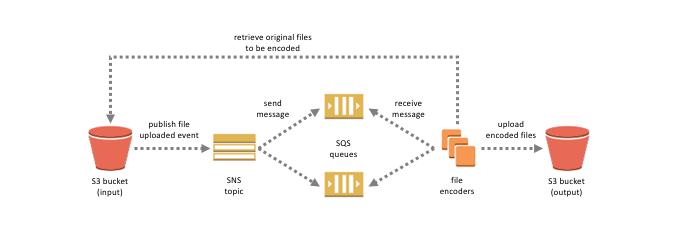- All Exams Instant Download
Which of the following would satisfy this requirement?
A company is using Amazon S3 to store frequently accessed data. When an object is created or deleted, the S3 bucket will send an event notification to the Amazon SQS queue. A solutions architect needs to create a solution that will notify the development and operations team about the created or deleted objects.
Which of the following would satisfy this requirement?
A . Create an Amazon SNS topic and configure two Amazon SQS queues to subscribe to the topic. Grant Amazon S3 permission to send notifications to Amazon SNS and update the bucket to use the new SNS topic.
B . Create a new Amazon SNS FIFO topic for the other team. Grant Amazon S3 permission to send the notification to the second SNS topic.
C . Set up an Amazon SNS topic and configure two Amazon SQS queues to poll the SNS topic. Grant Amazon S3 permission to send notifications to Amazon SNS and update the bucket to use the new SNS topic.
D . Set up another Amazon SQS queue for the other team. Grant Amazon S3 permission to send a
notification to the second SQS queue.
Answer: A
Explanation:
The Amazon S3 notification feature enables you to receive notifications when certain events happen in your bucket. To enable notifications, you must first add a notification configuration that identifies the events you want Amazon S3 to publish and the destinations where you want Amazon S3 to send the notifications. You store this configuration in the notification subresource that is associated with a bucket. Amazon S3 supports the following destinations where it can publish events:
– Amazon Simple Notification Service (Amazon SNS) topic
– Amazon Simple Queue Service (Amazon SQS) queue
– AWS Lambda
In Amazon SNS, the fanout scenario is when a message published to an SNS topic is replicated and pushed to multiple endpoints, such as Amazon SQS queues, HTTP(S) endpoints, and Lambda functions. This allows for parallel asynchronous processing.

For example, you can develop an application that publishes a message to an SNS topic whenever an order is placed for a product. Then, SQS queues that are subscribed to the SNS topic receive identical notifications for the new order. An Amazon Elastic Compute Cloud (Amazon EC2) server instance attached to one of the SQS queues can handle the processing or fulfillment of the order. And you can attach another Amazon EC2 server instance to a data warehouse for analysis of all orders received. Based on the given scenario, the existing setup sends the event notification to an SQS queue. Since you need to send the notification to the development and operations team, you can use a combination of Amazon SNS and SQS. By using the message fanout pattern, you can create a topic and use two Amazon SQS queues to subscribe to the topic. If Amazon SNS receives an event notification, it will
publish the message to both subscribers.
Take note that Amazon S3 event notifications are designed to be delivered at least once and to one destination only. You cannot attach two or more SNS topics or SQS queues for S3 event notification. Therefore, you must send the event notification to Amazon SNS.
Hence, the correct answer is: Create an Amazon SNS topic and configure two Amazon SQS queues to subscribe to the topic. Grant Amazon S3 permission to send notifications to Amazon SNS and update the bucket to use the new SNS topic.
The option that says: Set up another Amazon SQS queue for the other team. Grant Amazon S3 permission to send a notification to the second SQS queue is incorrect because you can only add 1 SQS or SNS at a time for Amazon S3 events notification. If you need to send the events to multiple subscribers, you should implement a message fanout pattern with Amazon SNS and Amazon SQS.
The option that says: Create a new Amazon SNS FIFO topic for the other team. Grant Amazon S3 permission to send the notification to the second SNS topic is incorrect. Just as mentioned in the previous option, you can only add 1 SQS or SNS at a time for Amazon S3 events notification. In addition, neither Amazon SNS FIFO topic nor Amazon SQS FIFO queue is warranted in this scenario. Both of them can be used together to provide strict message ordering and message deduplication. The FIFO capabilities of each of these services work together to act as a fully managed service to integrate distributed applications that require data consistency in near-real-time.
The option that says: Set up an Amazon SNS topic and configure two Amazon SQS queues to poll the
SNS topic. Grant Amazon S3 permission to send notifications to Amazon SNS and update the bucket to
use the new SNS topic is incorrect because you can’t poll Amazon SNS. Instead of configuring queues
to poll Amazon SNS, you should configure each Amazon SQS queue to subscribe to the SNS topic.
References:
https://docs.aws.amazon.com/AmazonS3/latest/dev/ways-to-add-notification-config-to-bucket.html
https://docs.aws.amazon.com/AmazonS3/latest/dev/NotificationHowTo.html#notification-how-to-overvie
w
https://docs.aws.amazon.com/sns/latest/dg/welcome.html
Check out this Amazon S3 Cheat Sheet:
https://tutorialsdojo.com/amazon-s3/
Amazon SNS Overview:
https://youtu.be/ft5R45lEUJ8
Latest SAA-C03 Dumps Valid Version with 400 Q&As
Latest And Valid Q&A | Instant Download | Once Fail, Full Refund
Subscribe
Login
0 Comments
Inline Feedbacks
View all comments

